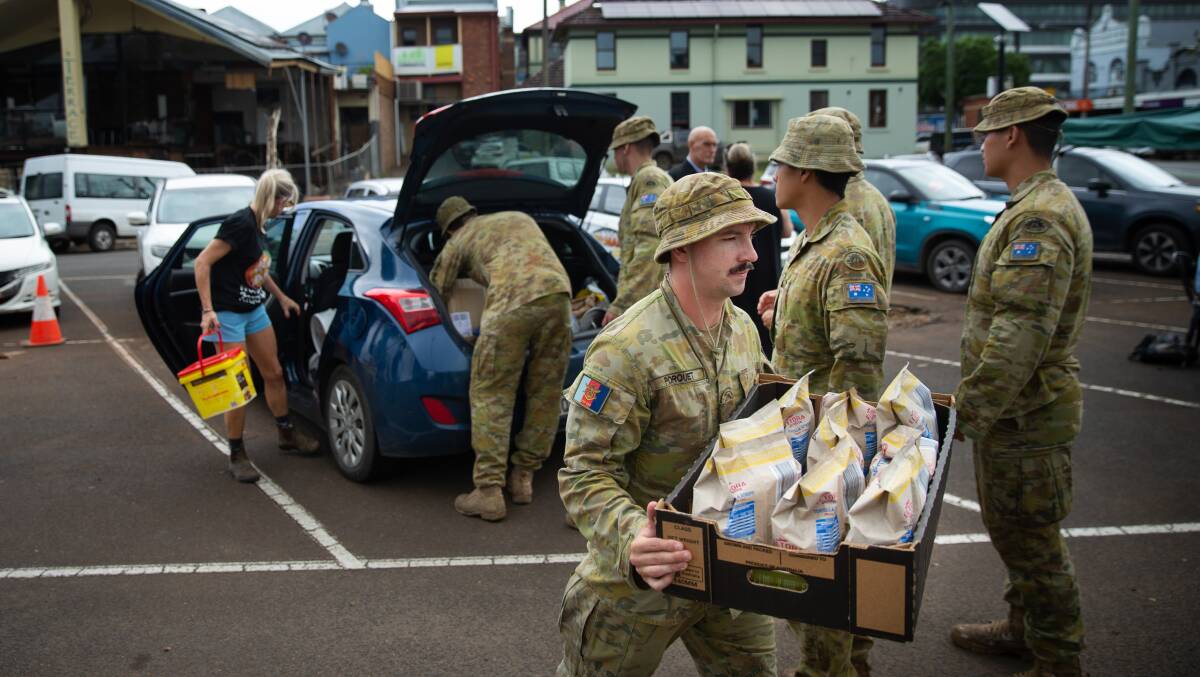
The most comprehensive review of our defence arrangements in decades has sparked a massive $19 billion spend by the government to make sure our Australian Defence Force can keep Australians safe in the new era of threats we face today.
Subscribe now for unlimited access.
or signup to continue reading
But while we've seen multibillion-dollar investments to prepare for possible wars through acquiring nuclear submarines, more lethal missiles and making guided weapons here in Australia, plans are much less apparent for how we will address the clear and present danger to our domestic and regional security: climate change.
The review points out that the ADF's increasing involvement in back-to-back bushfires, floods, and other extreme weather disasters inside our borders is straining Defence resources even as risks to our national security outside our borders are increasing.
The resulting advice to governments - stop drawing on the ADF except in the most extreme circumstances - seems a tough pill to swallow. But it's the right call. State, territory and local governments have to step up.
While the ADF was the "go-to" fix for the previous government, diverting finite and ill-prepared defence equipment and personnel to help with disaster response was always going to be unsustainable.
That said, the ADF has niche capabilities in disasters that civilian emergency services will need continued access to, like emergency bridging for damaged roads, heavy lift helicopters, leveraging local ADF reserve units when needed, and transporting disaster relief and assistance to our closest neighbours.
Some proposed alternative arrangements, like a new arm of the ADF to deal with disasters, or a new volunteer agency in each state or territory, would be wildly expensive and impractical. Why duplicate existing networks and services when it would be faster, cheaper and far more effective to leverage and expand existing emergency services and empower local communities?
Volunteer rural fire services and the SES already have local command and control networks and their members are locals. These agencies need new funding and internal capabilities to prepare communities for disasters, train spontaneous disaster volunteers (like the "tinny flotilla" that rescued so many in Lismore), and work on resilience projects that will improve disaster readiness and community-led recovery.
MORE DEFENCE REVIEW:
- What the Strategic Defence Review means for Australia | Bradley Perrett
- Defence's future is a machine's world. So, who's really boss? | Sarah Basford Canales
- Strike missiles: the key to deterring an enemy | Bradley Perrett
- Hastie proposes 'AUKUS tsar' to oversee subs acquisition | Karen Barlow
- Into orbit: Australia to exploit space for defence | Bradley Perrett
Ideally, they would be backed up by the smaller, specialised full-time fire and rescue services that already have units deploying internationally for earthquake rescue, rebuilding after disasters, and conducting rapid damage assessments using drones and other advanced technologies. These capabilities exist and can be readily expanded, but it won't be cheap.
So how can we pay for this? A very good place to start would be to make fossil fuel industries that are fuelling the climate emergency pay for the urgent measures needed to adapt to compounding and concurrent extreme weather events.
The Australian government gives some $11.1 billion a year in subsidies to fossil fuel industries, while collecting a pittance through taxes. This money and increased taxes should fund measures to keep Australians safe rather than generating super profits for corporations.
The revamp of our defence strategy must also address the intrinsic link between climate change and national security. A decade of climate inaction by the former government weakened Australia's standing in the Pacific, a relationship critical to the stability of our region.
Countries like the Solomon Islands, Kiribati and Vanuatu, furious at Australia's inaction on climate change, looked elsewhere - namely, China - for solutions to their problems. Whether it's collaborating on security arrangements or accepting development funding, China's influence in the region is undoubtedly growing, with major implications for Australia.
Sadly, the region faces increasingly devastating cyclones, sea level rise, and other climate impacts. Nobody wants to be a climate refugee, but many communities are having heartbreaking choices forced upon them. If climate disasters are not properly managed, those who lose their homelands could seek safety here in Australia.
MORE DEFENCE REVIEW:
- No time to lose: work on Adelaide submarine yard will begin this year | Bradley Perrett
- NATO's growing interest in 'lifeblood of global economy' | Sarah Basford Canales
- 'Urgent': northern bases need immediate toughening | Bradley Perrett
- Diplomacy must lead Australia's efforts in the Pacific | Mihai Sora
Australia has an obligation to assist when extreme weather events impact the Pacific and to increase aid programs. Upgraded state and territory emergency services will need to be ready to be deployed, and they will need the ADF to transport personnel and heavy equipment to areas with damaged ports and airfields.
Repairing our relationship with the Pacific requires us to take meaningful action on reducing emissions, to match the level of our assistance to the scale of the problem, and to properly implement the Defence Strategic Review recommendations.
Ultimately, government and defence decision-makers should heed the urgent imperative to swiftly reduce Australia's greenhouse gas emissions, phase out fossil fuels, and rapidly invest in measures needed to keep Australians safe from worsening disasters.
The safety of every Australian and the security of our region depends on this.
- Major General Peter Dunn, former Emergency Service Authority commissioner and Greg Mullins, former Fire and Rescue NSW, commissioner are members of Emergency Leaders for Climate Action.

